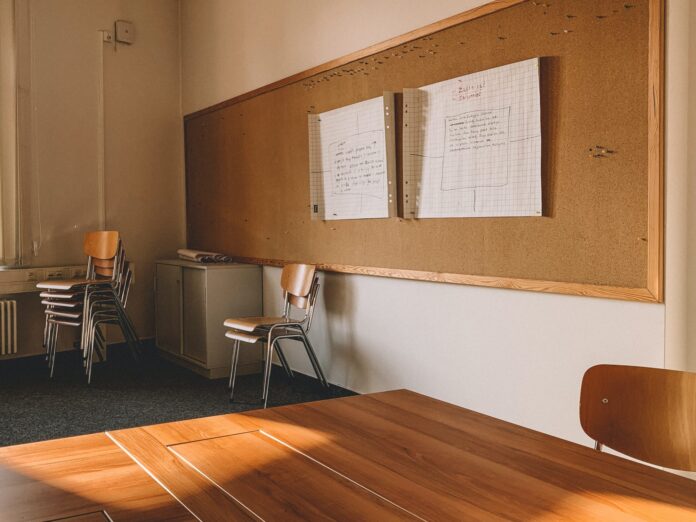Editor’s note: This article was originally published in the Border Belt Independent.
Robeson County schools planned to use $14.6 million in federal money to make much-needed upgrades at some of its buildings: Replace the heating and air system at Lumberton High, add classrooms at two other high schools and replace the windows at three elementary schools.
So school leaders were shocked when the U.S. Department of Education said late last month the promised money, which had been part of COVID-19 relief funds, was canceled.
“It was completely out of the blue,” Richard Schwartz, the attorney for Public Schools of Robeson County, said at a school board meeting on Tuesday. “I find it quite frankly mind-boggling and appalling legally, ethically and morally.”
Three other North Carolina school districts—Halifax, Lenoir and Richmond counties—are also affected by the abrupt cuts to the Education Stabilization Fund created in 2020. Together, those districts are set to lose more than $1.1 million.
The $14.6 million cut to Robeson County schools “threatens the financial integrity” of the district, which serves more than 20,000 students in southeastern North Carolina, state schools Superintendent Maurice “Mo” Green said in a statement urging Education Secretary Linda McMahon to reverse her decision.

The Robeson County school board voted on Tuesday to allocate $2.2 million from its budget to pay contractors, who have already started work on some of the projects. While the vote was unanimous, many members of the nonpartisan board—made up of six Democrats and five unaffiliated voters—expressed frustration.
“These contractors we promised money still deserve to get paid for their work,” said board member Craig Lowry. “I just wish someone in Washington would get some sense in their head.”
Board member Terry Locklear said Robeson County schools were “hung out to dry.”
“We are really going to bear the brunt of this,” he said, “and I have a hard time believing anyone will come to save us.”
Robeson ranks last in the state for local per-student spending, according to the Public School Forum of North Carolina. The county, where nearly 30% of people live in poverty, lacks a significant tax base that allows wealthier counties to allocate larger amounts of local money to schools.
Through the Elementary and Secondary School Emergency Relief (ESSER) program, part of the broader Education Stabilization Fund, federal money was distributed to school districts in three rounds between March 2020 and March 2021. Each round had different restrictions on what the money could be used for and varying deadlines for when the funds had to be spent.
Schools could use the federal money to hire teachers and other staff. They could also use it “for construction, renovation, repairing and improving school facilities to reduce risk of virus transmission and exposure to environmental health hazards, and to support student health needs,” according to the N.C. Department of Public Instruction.
North Carolina has spent 99% of its total ESSER allocation, with $44.3 million remaining, according to data from the U.S. Department of Education.
As of February, Robeson County had spent only 74% of its $156.6 million in ESSER funds, leaving nearly $40 million unspent, according to an analysis by Edunomics Lab at Georgetown University. All of the unused funds are from the third round of allocations.
Much of the unspent money is due to construction delays, according to Bobby Locklear, assistant superintendent of Robeson County schools. Supply chain issues for HVAC units and windows stalled projects. One piece of HVAC equipment took 58 weeks to be delivered.
Construction crews can only work when students and staff are out of the buildings for extended periods, like holiday breaks and summer vacations, Locklear said.
Robeson County schools applied for an extension to spend the money, which was originally granted under the Biden administration through early 2026.
But in a March 28 letter, McMahon said the funds were terminated immediately. She justified the cancellation of the money, saying the emergency that led to the funding—COVID-19—is over.
“Extending deadlines for COVID-related grants, which are in fact taxpayer funds, years after the COVID pandemic ended is not consistent with the Department’s priorities and thus not a worthwhile exercise of its discretion,” McMahon said.
McMahon and department officials said the remaining funds should be spent on addressing lasting academic effects of the pandemic, like continued learning loss.
The $11 million HVAC project at Lumberton High School had been on the district’s wish list for years, but there was never enough money, Locklear said. The federal program offered a way to get it done.
“We knew those funds were our time to swing big,” Locklear said, “because we might not get this opportunity again.”
In a joint statement on April 3, Green and Eric Davis, chairman of the North Carolina State Board of Education, strongly urged McMahon to reconsider the decision to rescind the money, saying it “introduces unacceptable uncertainty into school operations.”
“This unprecedented action undermines the careful financial planning of school districts across North Carolina and threatens critical programs supporting students,” they said.
Robeson County schools could re-apply for an extension to receive the money, a process that will be reviewed on a project-by-project basis.
“If they don’t re-approve our extension request, we just don’t have $14.6 million lying around,” said Chief Financial Officer Erica Setzer. “The impact on Robeson County is enormous, compared to everybody else.”
Schwartz said the move is unprecedented.
“This is a real yank the rug like nobody has ever seen before,” he said. “The arrogance with which this has been done is astounding.”





